Is Hardware Acceleration for Encoding Videos Bad for Youtube Uploads
How Does Hardware Dispatch Piece of work to Boost 4K UHD Video Processing?
 By Candice Liu to hardware acceleration| Last Updated on March ten, 2022
By Candice Liu to hardware acceleration| Last Updated on March ten, 2022
The switch of modern videos towards higher quality resolutions increases the brunt on CPU, which leads to CPU overheating, laptop lagging, loftier CPU usage, frozen operations and battery suffers. Hardware acceleration, past exploiting GPU's massive parallel processing power, turns out to be the well-nigh efficient solution to cut time and energy consumptions. Specially, hardware acceleration solutions let 4K ultra HD HEVC H.265, HD H.264 video processing go far beyond the traditional CPU-in efficiency.
For example, if the computer is equipped with Maxwell-based Nvidia graphics card from the GeForce 900 series or later, Nvidia hardware encoder tin take intendance of the 4K HEVC processing and get 2-3x faster than using Handbrake. The HW accelerated speed doesn't stop all the same. GPU'southward high video processing performance is further proven by MacX Video Converter Pro'south unique 3-Level Hardware Acceleration (HWEnc, HWDec & HW processing), which offers a 5x faster speed up over HWEnc-only tools, let alone other SW-based programs. It's time to look deeper into the function that hardware acceleration plays in HD video processing.
- Part 1. What is Hardware Acceleration?
- Part 2. Why HW Accel is Of import for 4K Video Processing?
- Part 3. Which GPU Dispatch Yields Meliorate Result?
- Part iv. King of Speed: Level-3 Hardware Acceleration
- Function five. How Does HW Accel Improve 4K Video Processing Speed
- Part vi. GPU HW Acceleration - FAQ
Function i. What is Hardware Dispatch?
1. Definition
Broadly speaking, all the speed boosts achieved in video processing via hardware upgrade are referred to as hardware acceleration. The common ways that are usually used to accelerate the video processing include replacing the hard disk, increasing the memory, and utilizing more CPU cores... Strictly speaking, it ways using GPU'due south powerful graphics capability to practice the video transcoding. Specifically, in video transcoding, graphically-intensive tasks such every bit high-definition video processing are offloaded from CPU to specialized GPU/APU, which is more efficient than doing it only on CPU.
2. Hardware Acceleration vs Software Acceleration
Software dispatch is used to describe the process of optimizing a programme by the ways of built-in code optimization, algorithm upgrade, performance improvement, or other techniques to speed upward the program for video decoding and encoding. Basically, it still utilizes system resources and increases CPU burden. In contrast, hardware dispatch is to make the virtually use of the dedicated graphics cards or integrated graphics based on Intel QSV, Nvidia or AMD hardware acceleration solutions. Hardware dispatch, by dissimilarity, is far less CPU occupied and will dramatically reduce the waiting time for video processing, specially for 4K UHD and compute-intensive HEVC files.
Applications that back up GPU hardware acceleration on the market include: Windows Media Thespian, VLC Media Player, Handbrake, MacX Video Converter Pro, MediaCoder, PowerDirector, Movavi Video Converter, Wondershare Video Converter Ultimate and Any Video Converter Ultimate.
You have already known what hardware dispatch is, all the same you might be still unclear most the reasons why hardware acceleration improves video processing speed via offloading compute-intensive tasks to GPU instead of the general-purpose CPU. It doesn't matter. After you understand the basic architectures and features of CPU and GPU, you'll exist of a sudden enlightened.
3. CPU vs GPU Performance
CPU, with the general-purpose aspect, is capable of carrying out diverse kinds of instructions and delivers an excellent performance in multitasking. Meanwhile, CPU involves in a large number of bifurcation of jumps and interrupt handling when logical judgement is needed, which makes CPU internal structure complicated. GPU mainly handles the highly unified blazon of tasks with massive contained information and uninterrupted status. In short, CPU performs well in coping with loftier-enervating tasks while GPU does an excellent job in simple compute-intensive tasks. To exist specific:
Sophisticated Task: CPU Wins
From the architecture motion-picture show, it's clear to see that plenty of infinite is occupied by cache in CPU and the rest infinite is filled with powerful ALUs and complicated control logic, which are designed to handle operation latency, branch prediction and data forwarding. Insufficiently, GPU adopts energy efficient ALUs and overlong pipelines with very simple command logic and well-nigh omitted cache for high throughput, no branch prediction or data forwarding abilities. Thus, faced with a high-demanding task, CPU has sophisticated logic control to reduce latency via co-operative prediction and data forwarding to quickly response and perform upward to 64-bit double-precision floating betoken instructions while GPU lacks that ability.
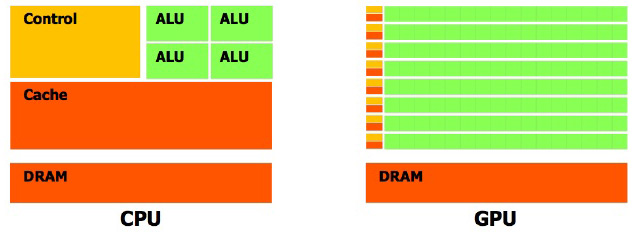
Compute-intensive Task: GPU Wins
Generally, a CPU chip only covers a few cores for sequential series processing while a GPU chip contains thousands of cores (or threads) to handle parallel workload or matrix computation. And basically computers decode and encode most video codecs like HEVC, H264, MPEG-4, VP9, etc. based on multi-cores and hyper threads. Therefore, when information technology comes to float-betoken ciphering or large-scale concurrent operations similar 4K video processing, video decoding/encoding, GPU has built-in advantage, able to parallel process large-sized video transcoding data based on thousands of threads, much faster than CPU. That's why GPU hardware acceleration is widely used in video processing, decoding and encoding.
4. Hardware Dispatch Workflow of Video Processing
Hardware acceleration transforms what used to be a time-consuming task into something you can cease at 2-3X faster speed. How does it go that manner? The post-obit HW acceleration workflow will enlighten you on this matter.
1). The first pace is the separation procedure of compressed video data, which is conducted by CPU. GPU and APU don't involve.
2). CPU hands over the compressed video and audio data to GPU and APU and the file information is transferred from organisation memory to graphic memory.
three). GPU and APU begin to hardware decode video data and salvage the decompressed file data on graphic memory. Basically, CPU is in idle condition if the workload doesn't exceed GPU capability. Of course, CPU would bank check the processing performance at present and then.
four). GPU and APU use their own circuits to decode video data (all the same saved on graphic retentiveness).
v). The post-processing task is also accomplished by GPU and APU like de-interlace, three:2pulldown, Doppler outcome, etc. CPU still has little participation.
6). GPU informs CPU after the media data processing is finished. CPU receives the rest of the job and begins to handle the video output process.

Function 2. Why HW Dispatch is Important for 4K Video Processing
Hardware acceleration is widely used in 4K Ultra HD video processing, video decoding & encoding, large file compression, video playback (especially high-def videos), online video streaming, web browser information loading, second/3D games, HEVC H.265 transcoding etc. You tin can notice information technology nigh everywhere. Why is it so popular? Whatever advantages of hardware dispatch that you can't resist? Really, yes. And information technology has more than one strength.
1). HW Acceleration Makes 4K Video Processing Faster than Ever
As is known to all, video processing involves big-scale computing tasks, most of which really are repetitive and don't take much logical relationship. To put it in another way, video processing mainly relies on parallel operation. That'southward what GPU is skilled in. GPU is born with SIMD architecture, abbreviation of Single Instruction Multiple Data, filled to skirt with thousands of cores to carry out the aforementioned instruction at the same time. Consequently, when GPU hardware acceleration tech is utilized in 4K video processing, transcoding, editing, resizing and playing, the whole process will be dramatically improved at speed.
How much faster can hardware acceleration facilitate in 4K UHD video processing? It would be much clearer by using the specific example, e.g., Intel Quick Sync Video hardware dispatch. Assisted by the on-chip Intel® UHD Graphics 630 chip up to i.20 GHz dynamic frequency and 60GHz 4K support, the 8th Generation Intel® Core™ i7 Processor (activated by software MacX Video Converter Pro) can hardware accelerate 4K 2160p (AVC) camcorder video to H264 conversion from avg eighty FPS to avg 270FPS, three-5X faster than that only on CPU. To put it simply, hardware acceleration can turn what used to be a time-consuming job into a task that y'all can attain with only one/three or 1/5 fourth dimension.
2). Ease CPU Burden for Better Responsiveness in Multi-tasking
Without the assist of GPU hardware accelerated decoding and encoding, processing videos especially HD, 4K Ultra Hard disk drive videos or 3D contents will place a heavy burden on CPU. To process intensive videos smoothly, CPU has to attempt very difficult, generally 350% usage for i5 processor and 570% for i7 processor. When CPU has been eaten upwardly, information technology in turn causes CPU overheating and lags in response.
Using GPU hardware accelerated video processing tool like MacX Video Converter Pro is a different story. It'south able to hardware decode, encode and process 4K Ultra Hard disk drive video mainly on GPU processor instead of CPU via Intel QSV, Nvidia and AMD APP level-3 hardware acceleration techs. Thus, the used CPU usage of 4K video processing can be reduced from 350% to 280%, 570% to 430%, more CPU utilization saved for smooth multi-tasking, like web browsing, video game playing, etc.

3). Solve CPU Overheating Problem
Information technology would be much more than acceptable for your CPU to handble 4K H264 video processing like 4K H264 video transcoding or editing. All the same, when information technology comes to bargain with 4K HEVC video processing, your CPU processor tin can't go away from the overheating issue. Cuz the better coding effeciency of 4K HEVC comes at the price of increased ciphering complexity, 10X more compute ability needed than 4K H264. Therefore, it stands a high hazard to encounter the CPU overheating trouble during 4K HEVC video processing, especially 4K HEVC GoPro video editing. If the CPU temperature reaches 90°C or higher, it might be something wrong with your throttling, which could ruin your CPU within months to a year.
Fortunately, GPU hardware acceleration comes to rescue your CPU processor past assigning heavy job from CPU to GPU processor to cope with the compute-intensive even so parallel-oriented chore. Thus, your CPU overheating problem can be easily tackled.
4). Quality Can't be Compromised for the Pursuit of Speed
Generally, video processing speed is inversely proportional to video quality. That happens when the video converter uses its congenital-in conversion algorithm to ditch away some unnecessary and less important file data during processing to reduce file data and so accelerate conversion speed. Yet, things are different to hardware acceleration, which makes total use of your estimator hardware configurations (CPU & GPU processors) to give a nifty boost on video processing speed, cypher damage on your video quality.
v). HW Acceleration is Available to Most Computers
4K Ultra Hd video can be accessible virtually everywhere. Similarly, hardware acceleration tin exist available to most computers with full general configurations. The entry-level requirements are a trivial scrap different based on the specific hardware acceleration you use on your computer. To exist specific:
• Intel® Quick Sync Video: this hardware decoding and encoding tech can be activated to use in video processing equally long equally the computer is equipped with 1st-6th generation Intel® Core™ i3/i5/i7 processor and Intel® HD graphics GPU or Intel® Iris™ graphics GPU. That's to say, majority of the current computers satisfy the basic conditions, no matter the computer sports with integrated graphics or discrete graphics menu.
• Nvidia: as for the most common H264 video decoding and encoding, the figurer armed with the 1st generation Kepler (Quadro K420) and GK107 chip sports with Nvidia hardware acceleration technology, no more than demands on the quantity of Nvidia chip. In respect to HEVC (H265) video processing, higher demands are needed, at least Maxwell (2d Gen) with Quadro M4000 and GM204 ship. More importantly, 2 NVENC fries should be installed. In most cases, in that location is no problem for your computer to hardware decoding and encoding H264 video. Just properly upgrade your hardware configurations when hardware encoding HEVC files.
six). Lower Power Consumption
Hardware acceleration has the dedicated module and unit of measurement to handle video esp. large-sized 4K video processing, which maximizes fixed functions for Cydn reduction and makes video transcoding no longer confine to desktop. Information technology's similar to loftier-rise elevator. High-rise elevator tin can assist you directly attain the tiptop floor (e.g., twoscore/F) like a cork without climbing the floors, much power saved. The ordinary stairs can send you to the top flooring, likewise, just you take to get through each flooring, which consumes much more than energy and time than high-rising lift. No wonder the bulk of computers and software feature GPU hardware acceleration to provide users with faster and better user experience in video processing.
Part 3. Which HW Acceleration Yields Improve Result?
Updated: Apple disclosed its latest Mac Studio powered by M1 Max or M1 Ultra chip to further become head to head against Intel'due south CPU scrap. And information technology's reported that Mac Studio with M1 Max chip runs 2.5x faster in CPU performance than the fastest 27-inch iMac with Intel 10-core processor and that Mac Studio enhanced by M1 Ultra flake even improves the CPU functioning up to iii.8x faster than the 27-inch Intel 10-core processor powered iMac. Thus, if you wanna experience even faster speed, Mac Studio 2022 powered by Apple's flagship M1 Max or M1 Ultra fleck is an electrifying option (the precondition is your acceptance to its high price, from $1999). If budget is tight, rely more on the software with GPU hardware dispatch tech for speed acceleration!
1. Intel® Quick Sync Video
Intel Quick Sync Video, ane of the most commonly used hardware acceleration techs, takes full advantage of dedicated media capabilities of GPU on Processor Graphics to improve video decoding and encoding speed upward to two-3X existent time faster. This hardware encoding tech is available if you're running on a 2nd-seventh generation Intel® Core™ i3/i5/i7 processor with at least Intel® Hard disk graphics GPU or Intel® Iris™ graphics GPU. Besides, other underlining techniques on Processor Graphics also aid Intel QSV to further improve video processing speed, like Intel® Intru 3D Technology, Intel® Wireless Display, etc.
Which CPUs Support QuickSync HW Acceleration?
| CPU | Generation 2 | Generation 3 | Generation 4 | Generation 5 | Generation half-dozen | Generation 7 |
| Code Name | Sandy Bridge | Ivy Bridge | Haswell | Broadwell | Skylake | Kaby Lake, |
| Cadre i7 Farthermost Models | 3970X, 3960X | 4960X | 5960X, 5930X, 5820K | / | / | / |
| Cadre i7 Processor Models | 3930K, 3820, 2700K, 2600K... | 4930K, 4820K, 3770K, 3770, 3770S, 3770T | 4790K, 4790, 4790S, 4790T, 4785T, 4771, 4770.. | 5775C, 5775R | 7820X, 7800X, 6700K, 6785R... | 7740X, 7700K, 8700K, 8700... |
| Cadre i5 Processor Models | 2550K, 2500K, 2500, 2500S, 2500T, 2450P... | 3570K, 3570, 3570S, 3570T, 3550... | 4690K, 4690, 4670K, 4670, 4460, 4430... | 5675C, 5675R, 5575R | 6600K, 6685R, 6600... | 7640X, 7600K, 8600K, 8600... |
| Cadre i3 Processor Models | 2120T, 2100T, 2115C, 2105, 2102, 2100... | 3250, 3245, 3240, 3225, 3220, 3220T... | 4370, 4360, 4350, 4340, 4330, 4370T... | / | 6320, 6300, 6100... | 7350K, 7320, 8350K, 8300... |
| Pentium Models | / | G2140, G2130, G2120, G2120T, G2100T... | G3470, G3460, G3450, G3440, G3430... | / | G4520, G4500, G4500T, G4400... | G4620, G4600, G4600T... |
| Celeron Models | / | G1630, G1620, G1610, G1620T, G1610T | G1850, G1840, G1830... | / | G3920, G3900, G3900TE, G3900T | G3950, G3930, G4920, G4900.. |
| Pentium Gilt Models | / | / | / | / | / | G5600, G5500, G5400... |
| Supported Codecs | H.264/MPEG-4 AVC | H.264/MPEG-4 AVC | H.264/MPEG-4 AVC, VC-1, H.262/MPEG-2 Office ii | H.264/MPEG-four AVC, VC-ane and H.262/MPEG-2 Part two, VP8 | H.264/MPEG-4 AVC, VC-one and H.262/MPEG-2 Part 2, VP8, HEVC principal/8-bit, fractional HEVC 10-chip, fractional VP9 | H.264/MPEG-four AVC, VC-1 and H.262/MPEG-2 Office ii, VP8, H265/HEVC, VP9 |
With a view to properly control the text length, here nosotros just list out the part of the specific CPU processor models. Yous're suggested to visit ark.intel website, where you can check if your computer CPU processor and processor graphics back up Intel QSV hardware acceleration technology.
ii. Nvidia (CUDA/NVENC/NVDEC)
Nvidia CUDA accelerates 4K Ultra Hard disk video encoding speed by using the usual GPU rather than the general purpose CPU processor. Nvidia NVENC is a dedicated part of your GPU, which is designed to encode video only. That means NVENC won't participate in any other processing tasks if it'southward unrelated to video encoding. And the reason why NVENC quickly overshadows CUDA lies in that NVENC just has a little bit demands on bandwidth and memory and barely whatever demands on CPU/GPU. Nvidia NVDEC has a good partnership with NVENC, dedicated in video decoding to offload heavy computing burden from CPU.
Which GPUs Back up Nvidia HW Dispatch?
| Nvidia HW Acceleration | Support Codecs | Compages | Board | GPU Chip | CUDA Cores | of NVENC/NVDEC Fleck |
| NVENC | H.264 (AVCHD) YUV iv:2:0 | Kepler, Maxwell, Pascal, Volta | Quadro K420 or college | GK107 or higher | 797+ cores | 1 |
| H.264 (AVCHD) YUV 4:iv:iv/Lossless | Maxwell, Pascal, Volta | Quadro K620 or higher | GM107 or higher | 1000+ cores | 1 | |
| H.265 (HEVC) 4K YUV 4:2:0 | Maxwell (2nd Gen), Pascal, Volta | Quadro M4000 or higher | GM204 or higher | 1664+ cores | 2 | |
| H.265 (HEVC) 4K YUV 4:iv:4/Lossless/8K | Pascal, Volta | Quadro P400 or college | GP107 or college | 640+ cores | 1 | |
| NVDEC | H.264 (AVCHD) | Kepler, Maxwell, Pascal, Volta | Quadro K2000 or higher | GK107 or college | 797+ cores | 1 |
| H.265 (HEVC) | Maxwell (GM206), Pascal, Volta | Quadro M2000 or college | GM206 or higher | 1024+ cores | 1 |
To be specific, for NVENC hardware encoding H264 (AVCHD) YUV 4:2:0, you need to make sure that your GPU chip is at least Kepler (Quadro K420) with GK107 fleck or higher. As for H264 (AVCHD) YUV 4:4:four/Lossless hardware transcoding, please upgrade your GPU to Maxwell (1st Gen) with Quadro K620 board and GM107 chip. Well, when it comes to HEVC (H265) 4K YUV 4:2:0 hardware video encoding, the entry level has higher demands: Maxwell (2nd Gen) GPU scrap with Quadro M4000 lath and GM204 chip. More chiefly, you lot demand to install at least 2 Nvidia NVENC graphics cards.
If you wanna enable NVDEC hardware decoding on your desktop, bank check if your hardware configurations run into these requirements:
To hardware decode H264, your GPU graphics card comes from Kepler family at least, with Quadro K2000 and GK107 bit. One NVDEC chip is enough.
To hardware decode H265 (HEVC), Maxwell (GM206) with Quadro M2000 lath and GM206 or higher should be guaranteed. Similarly, at that place is no more than strict demand on the quantity of NVDEC flake. Simply one NVDEC chip has enough power to practise the H265 processing job. Of form, in example your calculator supports to install more than graphics cards, you lot can install another one to further boost HEVC video processing speed. For more than detailed data, delight have a check on NVENC Back up Matrix on Nvidia official website.
Note: more often than not, higher configurations, faster speed. GPU hardware encoding is highly related with your GPU configurations. You lot can't install multiple CPUs on your PC merely you can install several detached graphics cards upward to 4 (based on your calculator configuration) to dramatically improve big-sized 4K or 8K UHD video processing speed. Of grade, it's not simply about the quantity of GPU cards only the loftier-level configurations of GPU graphic cards.
three. AMD APP
AMD APP, the abbreviation of AMD Accelerated Parallel Processing, is a GPU hardware acceleration to requite a great boost to 4K Ultra HD video quality and meanwhile accelerate software performance. Slightly dissimilar from the to a higher place Intel QSV and Nvidia, AMD APP makes both CPU and GPU sincerely cooperate with each other to jointly improve various applications processing speed. For this signal, CPU usage is seemingly higher than the previous QuickSync and Nvidia. Of grade, this is also continued with the workload.
| AMD APP Supported Graphic Cards | |
| For Desktop | AMD Radeon™ R7/R9 series graphics and AMD Radeon™ Hd 7000/8000 series graphics (OEM) |
| For Laptop | AMD Radeon™ Hard disk 7300M - 7900M series graphics and AMD Radeon™ HD 8500M - 8900M serial graphics |
Note: All the tablets above are provided for your reference just. You lot're suggested to go to Intel, Nvidia or AMD official website to check the detailed CPU or GPU information if your CPU/GPU version isn't found here.
four. Which Performs Best: Intel, AMD or Nvidia?
Intel QSV, AMD APP and NVIDIA also differ slightly in video processing. To make articulate the video transcoding performance of hardware acceleration technologies, below we will put them onto a set of transcoding tests.
Test programme: MacX Video Converter Pro.
| Test Hardware | |
| Platform | Gigabyte GA-H67MA-UD2H Intel Core i7 CPUx980 3.iii GHz, 24GB RAM |
| Graphics | AMD Radeon Hard disk 7970 2 GB Nvidia GeForce GTX 680 Intel HD Graphics 3000 (Sandy Bridge) |
| Hard Bulldoze | Intel X25-Chiliad 160 GB SSDSA2M160G2GC, SATA 3Gb/due south |
| Power Supply | Sparkle m W, 80 PLUS |
| Exam Software | |
| Operating System | Windows seven Ultimate 64-bit |
| MacX Video Converter Pro | MacX Video Converter Pro V6.4.1 |
Transcoding speed
Input: MPEG4 Hard disk drive 1080P, x minutes one.5GB
Output: H.264 480x360
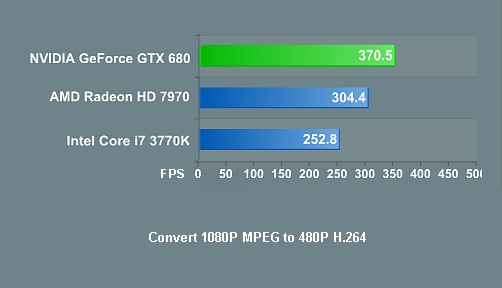
Input: MKV H.265 4K, 10.54 minutes three.7GB
Output: H.264 1080x720
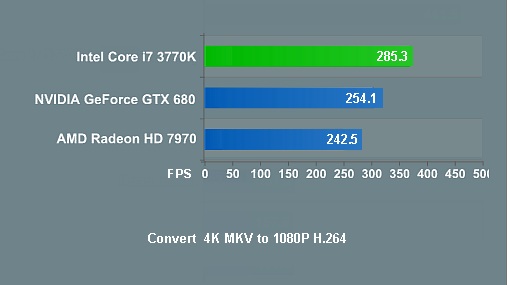
• In that location are around ii to 3x speed improvements using the iii hardware acceleration technologies. However, the encoding speed varies dealing with dissimilar videos: when transcoding 720P video, NVIDIA and AMD are faster; when processing 2046p video, Intel QSV has a slight speed reward.
• NVENC performs equally well to Quick Sync when encoding at a high resolution, say total Hard disk drive. Just when college compression ratios are implemented on encoding for lower-quality outputs, similar 1080p to 640p, Intel Quick Sync quickly surpasses NVIDIA.
• Every bit for the upshot on device free energy, a faster computer battery bleed is observed during NVIDIA encoding. To explain it clearly, here the results from an early exam carried out by Hardware.fr will be used. According to the test, Intel hardware transcode engine is more free energy efficient than NVIDIA, with an avg. power consumption of 0.83w/h vs iii.2w/h.
Encoding quality

• AMD now shows a notable quality comeback than that with AVIVO. Hither the AMD's color saturation plays a more than pregnant function to make the scene expect brighter. Simply effulgence may easily wash out details, which used to be a mutual trouble of AMD when the brightness changes significantly.
• Intel and NVIDIA's motion compensation algorithms do a better job in delivering more details. While there is minor graininess observed in the grass on the left corner in AMD picture, there is almost no aliasing around the shapes and less blurred backgrounds in latter two images.
• While it'southward difficult to tell the quality differences between Intel and NVIDIA by man eyes, there are some measurements to help. The Hardware.fr tests have recorded that differences based on PSNR and SSIM. Indicated in the results, Quick Sync scored higher in both PSNR and SSIM benchmarks than NVIDIA did. Apparently, Intel Quick Sync is way better than NVIDIA NVENC in quality at the same amount of CPU load.
Decision: All the three hardware acceleration solutions tin can deliver a two to 3x speed boost. The differences in the video transcoding efficiency are mainly determined by the source video.
ane. When the source video is within the processing adequacy of GPU, NVIDIA and AMD are faster than Intel QSV.
ii. When the source video is too big, like large 4K Ultra HD or 3D videos, and then Intel QSV shows a slight ascendant than the two others.
Part 4. Which Level of HW Dispatch Does Your Software Reach?
Currently, there are sheer number of programs offering support to hardware acceleration, including Handbrake, MacX Video Converter Pro, Movavi Video Converter, Wondershare Video Converter Ultimate, Any Video Converter Ultimate and many others. Nonetheless, they are not created equally. Some might only have the ability to admission hardware encoding (aka. Level-1), some are armed with hardware decoding/encoding (aka. Level-2) and others achieve new top - Level-three hardware acceleration (HWDec, processing & HWEnc). Well, Here come the questions - which level of HW acceleration is improve and which one supports Level-3 HW acceleration? Check below to find the answer that you desire.
What is Level-three Hardware Acceleration?
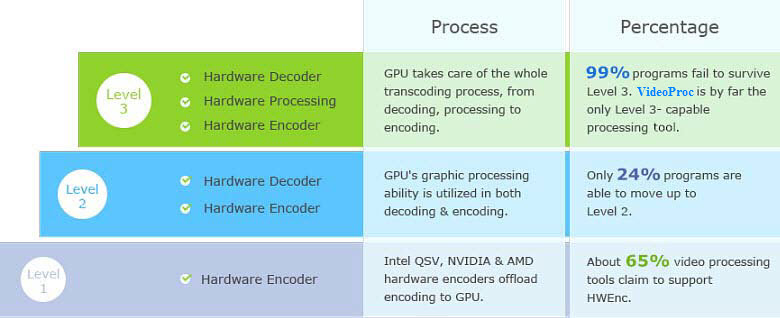
Level 1- Hardware encoding
Video encoding is a processor-intensive procedure. Information technology will consume 90% or even higher CPU ability if it relies on software encoding. To relieve CPU from the crushing video encoding task, hardware encoding is the key, which is why majority of software features hardware encoding to improve Hd video encoding, esp. 4K 8K Ultra Hard disk video encoding speed. After the video is decoded by the software, Intel Quick Sync, NVIDIA and AMD hardware encoders, namely dedicated processors in GPU, activate GPU hardware acceleration capability of your estimator to handle 4K 8K HEVC/H264 video encoding job on powerful GPU carte instead of CPU processor. Most hardware-accelerated tools on the market support hardware encoding.
Level 2- Hardware decoding & encoding
HW decoders shift the decoding from CPU to GPU based on the video codec, graphic cards and operating system. HW decoder generates faster speed and meliorate battery mileage than even the most efficient SW decoders which require more CPU horsepower to offer the aforementioned video quality & smoothness. Currently, nearly of the accelerated programs in the manufacture fail to go to Level two.
Level three- Hardware decoding, processing & encoding
Besides the hardware acceleration in video decoding and encoding, the software can also allow the graphic bill of fare perform video editing, compressing and resizing of the decoded video. By far, 99% progams fail to offer back up for Level-3 Hardware Acceleration. MacX Video Converter Pro is the only Level three-capable video processing tool that implements a complete pure GPU hardware transcoding process. In comparison, its speed is 5x faster than the closest competitor.
Office 5. How Does GPU Dispatch Improves 4K Video Processing Speed
Some, if not all, might be curious virtually the procedure of how Level-3 hardware acceleration speeds up 4K video processing (esp. 4K HEVC) up to 5X faster. The pure text description is nowhere near as intuitive as its workflow. Allow's brainstorm with the 3-Level accelerated 4K video transcoding workflow to illustrate for you lot.
1. Level-3 HW Dispatch Boosts 4K Video Transcoding Speed
Pace 1. Free download the unique Level-3 4K video processing tool - MacX Video Converter Pro. Afterwards, fire it upwards on your calculator. You tin can see the Hardware Encoder "Intel/AMD/Nvidia" option will automatically exist ticked if your estimator supports ane of these HW acceleration techs. This also means the GPU acceleration tech is activated past this plan.
Step two. Import your 4K video source and then this GPU accelerated video processing software starts running to read and excerpt the individual elementary streams like 4K video, audio and subtitles from the raw data via a procedure called demux. And then the separate data volition be sent to the system memory. This footstep is very fast and will proceed the original quality.
Step 3. With the support for Level-three Hardware Acceleration, the software transfers the compressed video streams to CPU and CPU offloads these tasks to GPU processor. GPU takes a compressed bitstream as input and converts it to digital components video every bit output for post-processing. This stride is done past hardware GPU, thus chosen HWDec.
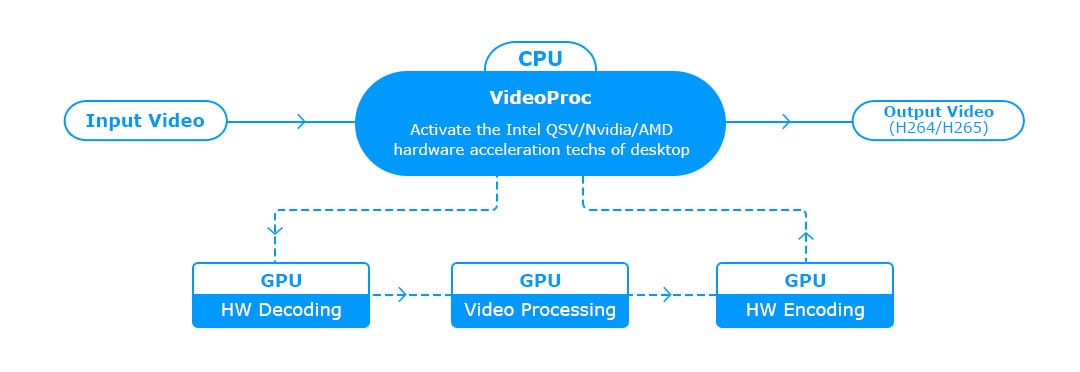
Step 4: The GPU keeps working. GPU contains comprises graphics, video, audio, and display capabilities to further procedure the video similar remove the nosie, calibration dimensions, acuminate, transcode the bit rates, frame rates, etc.
Footstep 5: GPU encoder now encodes the uncompressed digital video to a new rails, namely HWEnc. The most resource- and time-intensive processes in video transcoding are all done by GPU, during which the CPU is freed up to provide sufficient compute capability for gaming or other tasks on computer.
Pace half-dozen: Later the GPU video transcoder finishes, GPU sends the results back to MacX Video Converter Pro. So the software volition combine the 4K video, sound and subtitle component files and multiplex them into a new container file which tin can be read and distributed by common players, programs and devices.
2. Level-3 HW Acceleration Solves 4K Video Editing Laggy Trouble
It's not an exceptional example to run across the 4K video editing lagging trouble on your laptop or computer, for the general video editing is a processor-intensive job, let alone the 4K Ultra HD video in H265 or H264. That'southward the major reason why your CPU is overheating and sometimes the CPU usage reaches 90% or fifty-fifty higher when it proceeds 4K video editing. Fortunately, with this GPU accelerated 4K UHD video processing software, yous can edit 4K video thereon mainly on GPU processor to smoothly cutting, crop, add together subtitles, merge, rotate/flip 4K video without any off-putting lagging problem or CPU overheating trouble. The specific 4K video editing features include:
* Trim: tap "Trim" option at the video info bar to remove unnecessary video clips from your 4K video to control your 4K video length at your willing.
* Crop: enable "Ingather" and the marquee will appear to allow y'all freely suit video epitome width and summit to go rid of black bars from video and modify video aspect ratio to iv:3, 16:9, 1:1, 17:nine, etc. to better fit your 4K video playback device screen.
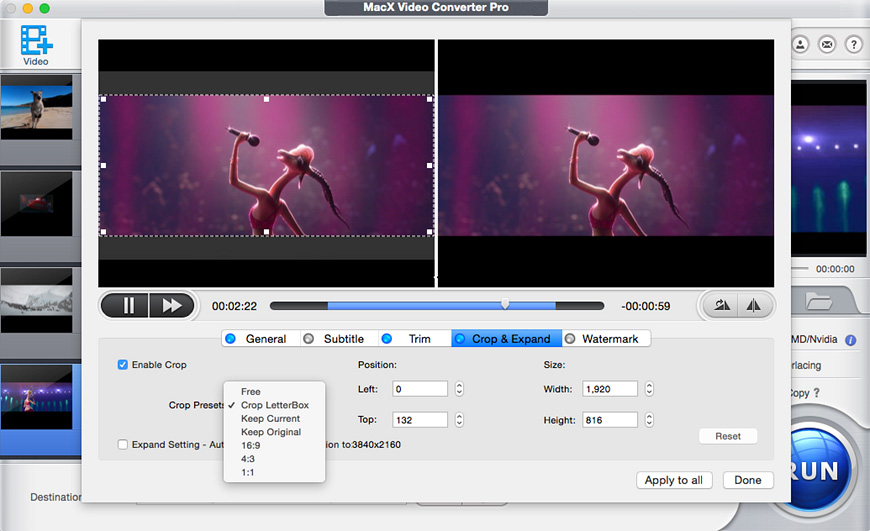
* Subtitle: for those movies that lack subtitles or are born with foreign linguistic communication subtitles, you lot can click "Subtitle" to add together external srt subtitles to your 4K movies or videos. And don't worry about the video subtitle out of sync issue, for this 4K video converter tin can automatically sync subtitles with video.
* Merge: opt for "Merge" to merge two or even more than video footages into one, which is especially useful for you to combine TV episodes into ane video and merge several funny clips into a new one for SNS uploading & sharing.
* Rotate: some 4K videos are recorded by your iPhone or Android in a vertical direction while you wanna playback information technology in a horizontal direction on some other bigger screen. Information technology's hands tackled by using "Rotate" characteristic to plow your vertical video to horizontal video. And it likewise empowers yous to flip your 4K video upside downward, as well equally rotate video xc/180/270 degrees.
More bonus features are provided by this HW accelerated 4K video processing tool, for instance: split, video to GIF conversion, mirror & Flip, transcode video to M3U8, export subtitles from video, excerpt snapchat from video and more. Only a uncomplicated click is needed to use them to your video. Just do equally you wish.
When everything is ready, tap "RUN" button and this HW accelerated 4K video processing software will begin to process 4K video editing job grounded on GPU hardware dispatch techs (Intel/Nvidia/AMD). Thus, the whole 4K video editing mission is delivered from CPU to GPU processor. Since GPU is designed with an compages of SIMD (Single Instruction Multiple Data), it has hundreds of cores to handle the same educational activity at the same time. The 4K video editing but happens to be this kind, parallel computing. Therefore, when the compute-intensive 4K video editing mission is handed over to GPU, GPU tin brand total use of its efficient notwithstanding heavily pipelined ALUs to deal with the 4K video editing task at high throughput. Fourth dimension is saved and 4K video editing laggy problem is fixed, also.
iii. Level-3 HW Acceleration Makes 4K Video Compressing 5X Faster
The above analogy covers three parts of hardware acceleration: HW decoding, HW video processing and HW encoding. Information technology'southward understandable for nigh users near hardware decoding and encoding. Nevertheless, it's comparatively strange to yous about HW video processing. Actually, video processing is responsible for treatment video compression, video editing, resizing, playing, etc. Well, how does HW acceleration affect 4K video processing speed? Here you lot'll be aware by 4K video compressing and editing. At present, let's cut to the chase: GPU acceleration in 4K video shrinking.
Step 1: After the 4K video hardware decoding is finished, you can cull the output format from the pop-upwardly window. Honestly, HEVC is a dandy option, 64% less fleck rates than H264. Of course, the higher coding effeciency of HEVC comes at the cost of a petty bit worse compatibility than H264. Beyond them, FLV, WMV and 3GP are also suitable for you lot with better compression ratio in video codec. Of grade, the output quality is afflicted, loss at a sure caste.
Step 2: To further reduce 4K video size, tap "Settings" icon at MacX Video Converter Pro'due south habitation screen and you'll be directed to the parameter aligning window, where you're allowed to lower 4K to 1080p, modify frame rate from 120FPS to 60FPS, 60FPS to 30FPS and downgrade chip rate to downsize 4K video.
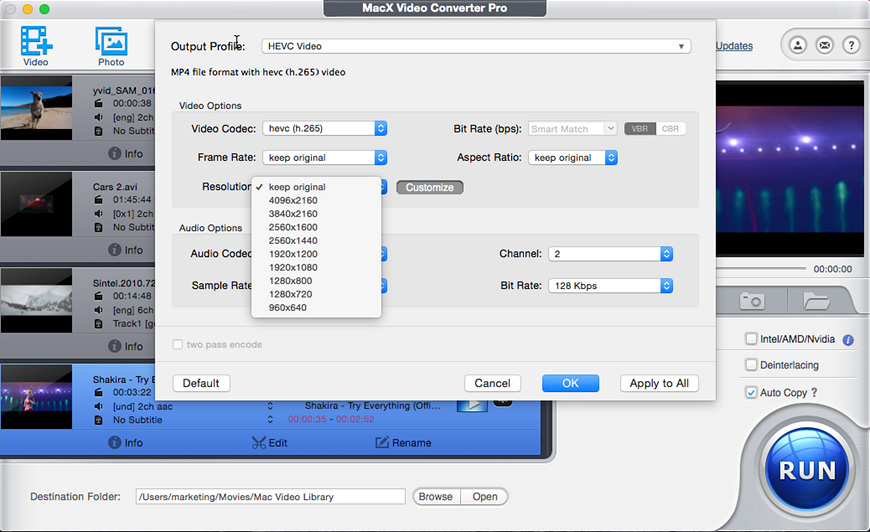
Step 3: To losslessly compress 4K Ultra HD video, opt for the scissor-shaped edit icon to utilise "Trim" and "Crop" features to resize 4K. Enable "Trim" to freely set the video get-go time and end time to shorten video length. Actuate "Ingather" feature to adjust video paradigm width and summit and remove black bars from video. These operations accept no impact on your video quality.
Pace iv: The concluding striking goes to "RUN" button. Then the GPU hardware acceleration will become into action to deal with 4K video compressing. The specific procedure is:
> The born intra-frame and inter-frame prediction volition be activated to do the cake transform work. Because both intra-frame and inter-frame prediction are typically matrix operations, they tin can exist hardware accelerated past GPU processor (GPU excels in matrix operations). Thus, the removal of spatial and temporal redundancy can be accomplished at GPU accelerated speed, much faster than before on CPU.
> The procedure of handling 4K video reduction also involves with DCT, Quantization and entropy coding, which used to place a heavy burden to CPU processor when hardware accelerated video processsing isn't available. Now, with the help of GPU accelerated video processing, the 4K file removal of perceptual and statistical redundancy can be even faster processed at powerful GPU processor (GPU is built-in for treatment the tasks related with DCT).
Part 6. Hardware Acceleration - FAQs
i. What Does Hardware Acceleration Exercise for Video Processing?
Hardware acceleration offloads graphics-intensive tasks like 4K Ultra Hard disk drive video processing, from CPU to GPU for more effective video processing.
2. How Do I Enable/Disable Hardware Acceleration in Video Processing?
Google Chrome:
Open Google Chrome, click the Options icon -- Settings > Advanced and turn on or plough off Utilise hardware acceleration when available.
Firefox (55+):
Open Firefox, press the Alt central, click Tools > Options > General, uncheck Employ recommended operation settings under Functioning department then you should see the option to enable or disable "Apply hardware acceleration when available".
Safari:
Become to Safari > Preferences > Security and check or uncheck "Let WebGL" nether Web content tab.
Internet Explorer:
Click Tools > Net Options > Avant-garde and check or uncheck "Use software rendering instead of GPU rendering".
Flash Player:
Go to Flash Histrion Help folio, right click on the logo, click Settings then click the icon in the bottom-left corner and select or uncheck "Enable hardware dispatch" for video processing.
3. When Should I Apply Hardware Acceleration?
You can cull to turn on hardware acceleration when your devices demand to do graphically intensive tasks like processing 4K UHD videos, encoding H.265 (HEVC) clips, playing 3D contents etc. Additionally, you have modern graphics card drivers, video cards, the latest version of applications to make certain y'all don't accept compatibility issues.
4. When Should I Disable Hardware Acceleration?
Hardware acceleration doesn't piece of work well all the time. Here're the cases when you demand to disable hardware acceleration.
• You have potent CPU simply weak or damaged hardware components, so hardware dispatch is properly low-performing.
• Your figurer has overheating issues or other problems subsequently hardware acceleration is enabled.
• You are experiencing poor functioning of software and applications, for examples, programs don't run stably or crash.
• You have other issues with hardware acceleration turned on when browsing, streaming or gaming.
5. Video Playback Issues with Hardware Acceleration?
With GPU acceleration, GPU does most of the video processing faster than CPU does, only sometimes it goes incorrect. Some users encounter one of the following video playback bug using their 4K video players with hardware acceleration turned on:
• Video playback is laggy or choppy or out of sync.
• Videos are corrupted during playback, the screen turns green & majestic or videos prove up green and pink layers.
• The graphics freeze or pocket-sized dots of color are spattered beyond the screen.
• Video doesn't play and there's a black or white box on the brandish and other issues.
Sometimes hardware acceleration is non compatible with one-time graphics cards, so you may run across problems when playing (YouTube, Vimeo, Hulu etc.) videos using flash player on Chrome/Firefox or local videos on Mac/Windows. The mutual solution is to plough off hardware dispatch.
six. Why Doesn't GPU Acceleration Piece of work?
The possible reasons for GPU acceleration not working fifty-fifty if yous have the Intel, Core, NVIDIA, CUDA, AMD graphics include:
• The graphics card or video card is damaged or they are out of date.
• Make sure you accept Hardware Acceleration enabled.
seven. Cannot Turn On Hardware Acceleration in AutoCAD?
Many users written report they tin can't enable hardware acceleration in AutoCAD and the setting is grayed out. Endeavor the following steps:
• Brand sure y'all accept hardware acceleration turned on.
• Update to the latest video driver.
• Reset AutoCAD to defaults.
8. How to Check If Chrome or Firefox Is Using Hardware Dispatch?
In Chrome, blazon chrome: //gpu in the URL bar and cheque nether Graphic Feature Condition.
In Firefox, type most:back up, and check under Graphics section.
Related Articles and Tips




Subscribe for News & Special
* Signup for latest news and special offers.
* Upwardly to 70% off hot deals for new members.

Source: https://www.macxdvd.com/mac-video-converter-pro/hardware-acceleration-video-processing-performance.htm
0 Response to "Is Hardware Acceleration for Encoding Videos Bad for Youtube Uploads"
Post a Comment